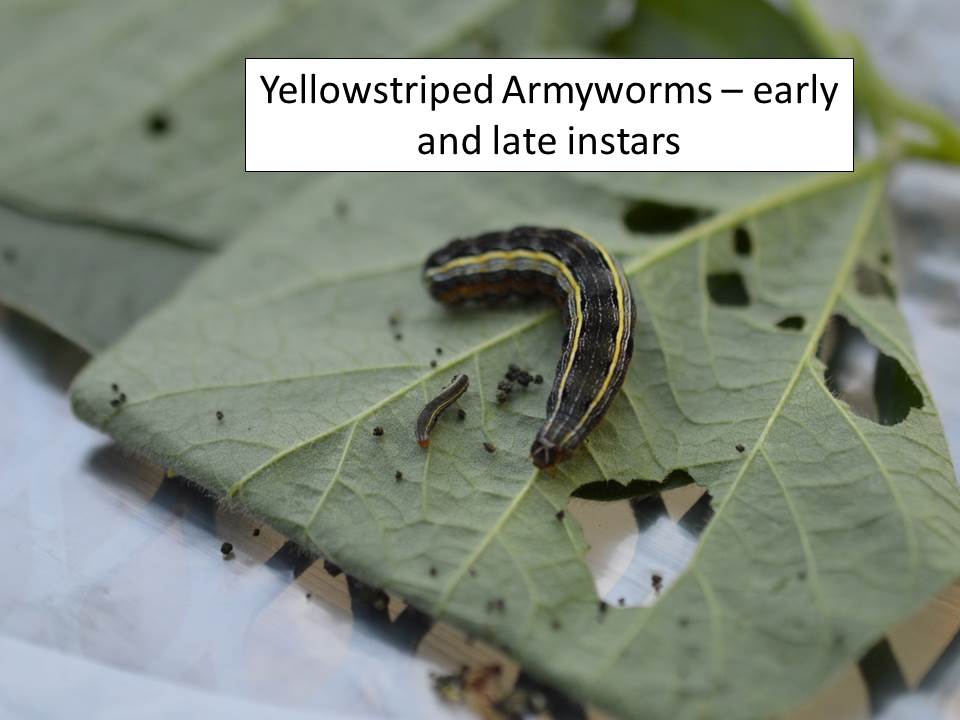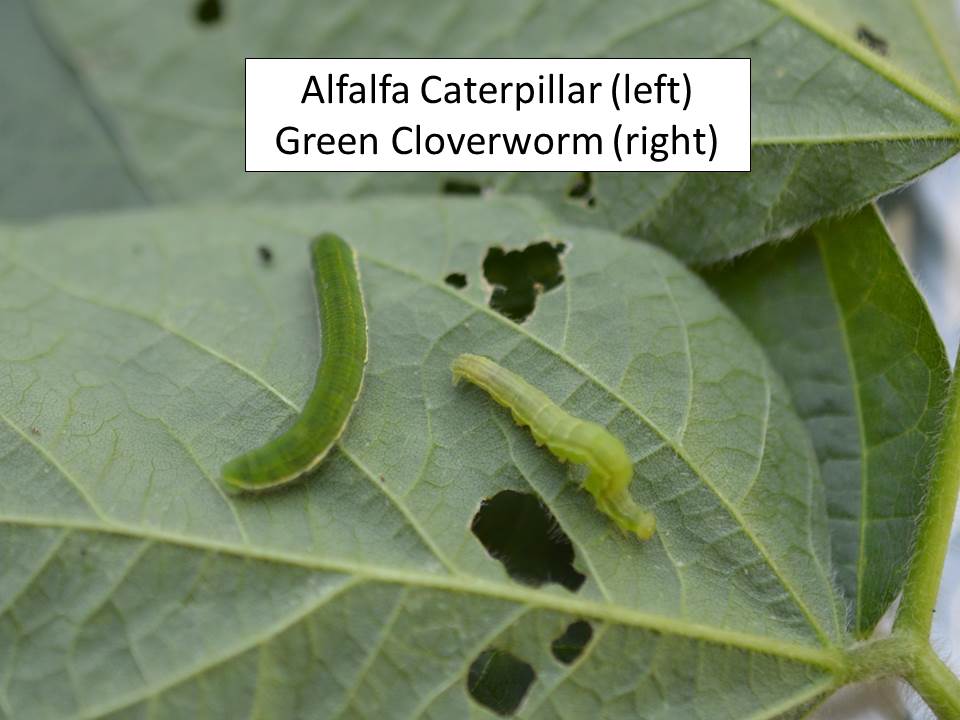–Jeff Whitworth, Extension Entomologist: Holly Schwarting, Entomology Research Assoc.; Steve Watson, Agronomy; Mary Knapp, Weather Data Library
Thanks to the unusually warm winter, alfalfa weevil larvae are already present in some areas. Many more will no doubt be hatching in the next few days to weeks. Alfalfa weevils will continue to hatch and larvae continue to develop any time temperatures exceed 48°F.
Thus, it looks like larvae will be emerging, and damage progressing, relatively quickly. Whether this warm weather will compress the alfalfa weevil larval feeding so that the period of damage is not as stretched out as usual remains to be seen. There are also lady beetles active in the alfalfa fields, as well as a few pea aphids. The treatment threshold we use for alfalfa weevil insecticide applications is 30-50% infestation, i.e. 1 larva/2-3 stems.
Alfalfa weevils are cool-weather insects. Adults lay eggs in alfalfa fields in the fall or even the winter. Most of these eggs survive the winter. Eggs hatch and larvae emerge after accumulating enough degree days or thermal units, normally in early spring. Alfalfa weevil adults also lay eggs in the spring, but in many cases the first larvae to emerge are from eggs that were laid in the fall and overwintered.
That said, an anomaly we encountered in the fall of 2016 was a significant infestation of relatively large (2nd and 3rd instar) larvae from mid-November to mid-December. Alfalfa weevils normally overwinter as eggs or adults – not larvae. In the last week we could find none of these more mature larvae, or any pupae. So, hopefully they perished in the colder weather.
Figure 1. Alfalfa weevil larvae collected Nov. 16, 2016 in Dickinson Co.
Figure 2. Alfalfa weevil larva collected Feb. 22, 2017 in Dickinson Co.
However, as of February 22 we did start finding newly hatched larvae in north central Kansas (Figure 2). Obviously the larvae hatching out now are coming from eggs deposited prior to Jan. 1, 2017. The return of below freezing temperatures may kill those very small, young larvae, especially if they stay in the plant terminals. But, they may survive if they crawl down the plant and get in the plant residue where they will be protected. So, scouting should continue as follows:
Early scouting for alfalfa weevil
Scouting for alfalfa weevil larvae should start after plants break dormancy – which means now. A degree day or thermal unit accumulation system can be used to predict when to initiate scouting. Insect development is controlled by temperature. This can be used to help manage these pests. Weevil activity has been tracked in Kansas for the past few years and has been used to generate recommendations (Table 1).
Table 1. Approximate degree days required for alfalfa weevil development
| Degree Days or Thermal Units | Stage | Importance |
| 25–300 | Eggs develop and hatch | In stems |
| 301–450 | 1st and 2nd instars | Leaf pinholing – start sampling |
| 450–600 | 2nd and 3rd instars | Defoliation |
| 600–750 | 3rd and 4th instars | Defoliation |
| 750+ | Pupa to adult | Adults – some feeding – oversummering |
To calculate a degree day, record the daily high temperature anytime it exceeds 48ºF. For example, if there is only one day in January that the temperature exceeded 48ºF, take that temperature and add the lowest temperature for that day, or 48ºF, whichever is higher. Then divide by 2 to calculate the average temperature for that day. Next, subtract 48ºF.
As an example, say there was one day in January when the high temperature was 60ºF and the low was 35ºF. You would use 48ºF as the default value for the low instead of 35ºF. The calculation in this case would be:
[(60 + 48)/2] – 48 = 54 – 48 = 6 degree days (or weevil development units)
The following chart from K-State’s Weather Data Library shows examples of the degree days that have accumulated for the period for Jan. 1 – Feb. 21, 2017 and for last fall:
Do not be too quick to treat for alfalfa weevil. Wait until the field reaches the treatment threshold. Treating too early is not only unnecessary, it can also have detrimental effects by killing beneficial insects.
For more details, see Alfalfa Weevils, K-State publication MF-2999, at your local county Extension office, or http://www.bookstore.ksre.ksu.edu/pubs/MF2999.pdf
Other early spring alfalfa insects
While scouting for alfalfa weevils, you will probably also notice a few pea aphids. These are also early season potential pests. However, in the past few years pea aphids have seemed to be adequately controlled by adult lady beetles. This year seems to be starting that way as well, with a few pea aphids, but also many adult lady beetles present.
Figure 3. Pea aphid on alfalfa leaf.
Also, producers need to keep an eye out for army cutworms as there were some reports of army cutworm activity last fall. Army cutworms start feeding again any time temperatures are above 50 degrees F. Armyworms are another potential problem, but probably a little later in the spring.
Those are the early season pests which have the most potential for damaging alfalfa prior to the first cutting. For more information on control, see K-State publication MF-809, Alfalfa Insect Management 2017, at: http://www.bookstore.ksre.ksu.edu/pubs/MF809.pdf



























